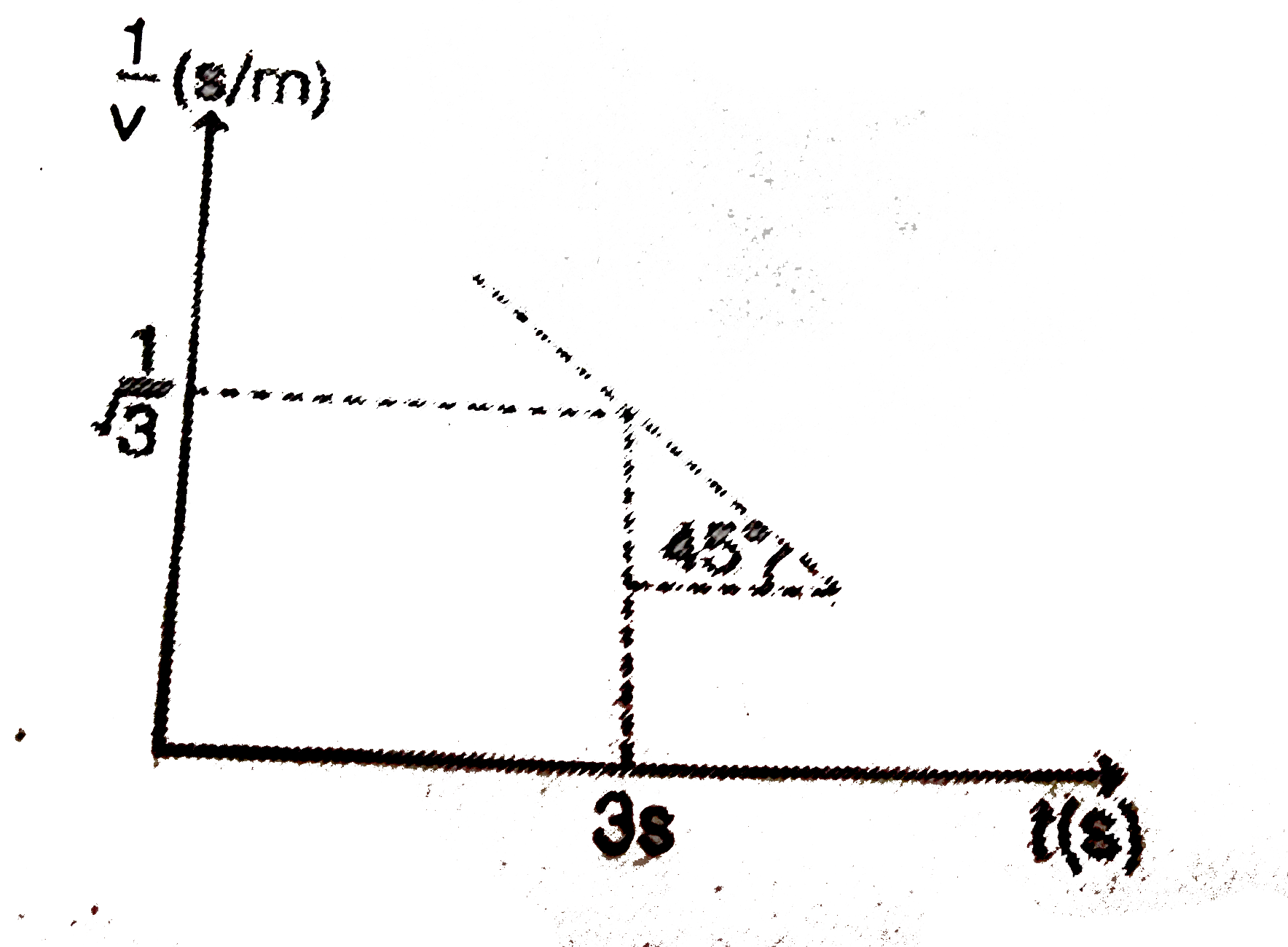The motion of a body is given by the equation dv/dt=6−3v, where v is in m//s. If the body was at rest at t=0
(i) the terminal speed is 2m/s
(ii) the magnitude of the initial acceleration is 6m/s2
(iii) The speed varies with time as v=2(1−e−3t)m/s
(iv) The speed is 1m/s, when the acceleration is half initial value
the terminal speed is 2.0ms−1
the magnitude of initial acceleration is 6.0ms−2
the speed varies with time as v(t)=2(1−e−3)m/s
the speed is 1.0ms−1 when the acceleration is half the initial value.
The correct Answer is:B, C, D
Acceleration, dv(t)dt=6.0−3v(t) …(t)
At t=0, acceleration =6.0ms−2
Thus option (b) is true
Form (i), dv6−3v=dt
Integrating it within the conditions of motion, we have ∫v0=dv6−3v=∫t0dt
lrt 6−3v=y or −3dv=dy or dv=−dy/3
:. ∫6−3v6−dy/3y=∫t0dtor∫6−3v6dty=−∫t03dt
(logey)6−3v6=−3t ltBrgt or loge(6−3v)−loge6=−3t
or loge(6−3v)−loge6=−3t
or loge(6−3v)6=−3t or (6−3v06e−3t
or 6−v=6e−t or 3v=6−6e3t
or v=2(1−e−3t) When ev(t)dt=12×6=3.0 theta from (i) we have
3=6.−3v(t)<br>or v (t) = (6.0-3)//3 = 1. 0 ms^(-1)
Thus , option (d) is true.
Topper's Solved these Questions
- BOOK - PRADEEPCHAPTER - KINEMATICSEXERCISE - 4 NCERT multiple Choice10videos
KINEMATICS
- BOOK - PRADEEPCHAPTER - KINEMATICSEXERCISE - 4 NCERT Integer type4videos
KINEMATICS
- BOOK - PRADEEPCHAPTER - KINEMATICSEXERCISE - 2 NCERT multiple15videos
KINEMATICS
- BOOK - PRADEEPCHAPTER - GRAVIATIONEXERCISE - Assertion-Reason Type Questions19videos
GRAVIATION
- BOOK - PRADEEPCHAPTER - LAWS OF MOTIONEXERCISE - Assertion- Reason Type Questions17videos
LAWS OF MOTION
Similar Questions
The motion of a body is given by the equation dvdt=4−2v, where v is the speed in m/s and t in second. If the body was at rest at t = 0, then find
(i) The magnitude of initial acceleration
(ii) Speed of body as a function of timeView SolutionThe position of a particle is given by x=7+3t3 m and y=13+5t−9t2m, where x and y are the position coordinates, and t is the time in s. Find the speed (magnitude of the velocity) when the x component of the acceleration is 36m/s2.
View Solution
Knowledge Check
- Question 1 - Select One
The motion of a body is given by the equation dνdt = 6−3ν where ν is the speed in ms−1 and t is time in s. The body is at rest at t = 0. The speed varies with time as
Aν=(1−e−3t)Bν=2(1−e−3t)Cν=1+e−2tDν=2(1+e−2t) - Question 2 - Select One or More
The motion of a particle moving along x-axis is represented by the equation dvdt=6−3v, where v is in m/s and t is in second. If the particle is at rest at t = 0 , then
AThe speed of the particle in 2 /s when the acceleration of particle is zeroBAfter a long time the particle moves with a constant velocity of 2 m/sCThe speed is 0.1 m/s, when the acceleration is half of its initial valueDThe magnitude of final acceleration is 6m/s2 - Question 3 - Select One or More
A particle is moving in a circle of radius 1 m with speed varying with time as v=(2t)m/s. In first 2 s
Adistance travelled by the particle is 4mBdisplacement of the particle is 2 sin 2Caverage speed of the particle is 2 m/sDaverage velocity of the particle is zero
The diagram shows the variatioin of 1/v (where v is velocity of the particle) with respect to time. At time t=3s using the details given in the graph, find the instantaneous acceleration (in m/s2)
 View Solution
View SolutionA body moves so that it follows the following relation dvdt=−v2+2v−1 where v is speed in m/s and t is time in second. If at t=0, v=0 then find the speed (in m/s) when acceleration in one fourth of its initial value.
View SolutionIf in the previous problem, particle A moves with constant acceleration 4m/s2 with initial speed 5m/s and B moves with uniform speed 12m/s, when and where the particle meet?
View SolutionA particle is moving in a circle of radius 1 m with speed varying with time as v = (2t) m/s. In first 2 sec:
View SolutionThe velocity v of a body moving along a straight line varies with time t as v=2t2e−t, where v is in m/s and t is in second. The acceleration of body is zero at t =
View Solution

